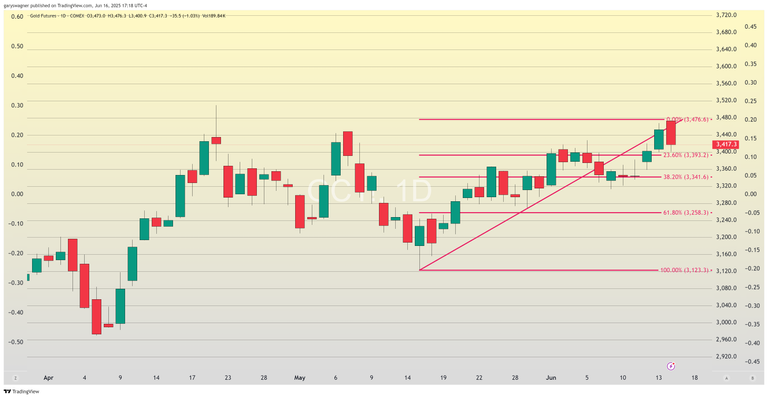Gold futures experienced a dramatic $50 decline following an initial gap higher, as market participants reassessed geopolitical risks emanating from escalating Middle East tensions. The precious metal's volatile session underscores the complex interplay between safe-haven demand and evolving risk perceptions in commodity markets.
Geopolitical Catalyst and Market Response
The outbreak of hostilities between Israel and Iran had previously propelled gold futures to a record closing price of $3,452.80 on Friday, reflecting investor flight to traditional safe-haven assets amid regional conflict concerns. However, Monday's trading session revealed a marked shift in market sentiment, with the initial fear-driven rally giving way to substantial profit-taking as traders grew increasingly confident that the conflict would remain geographically contained within the borders of the primary combatants.

Gold futures settled at $3,403.10, representing a $49.30 decline or 1.43% decrease as of 5:05 PM ET. This dramatic intraday reversal from strength to weakness suggests that market participants have recalibrated their risk assessments, viewing the probability of broader regional escalation as diminished compared to initial concerns.
Technical Pattern Formation
The recent price action has generated significant technical developments on daily candlestick charts, most notably the formation of what appears to be a triple top configuration. Each peak in this formation has been characterized by the emergence of dark cloud cover patterns, a bearish reversal signal that carries particular weight when occurring at major resistance levels.
The dark cloud cover pattern emerges through a specific two-candle formation that signals potential bearish reversal in uptrending markets. This technical pattern develops when an initial bullish candle with substantial body length is followed by a bearish candle that gaps higher on the open but subsequently closes within the lower half of the preceding candle's real body. The pattern's bearish implications stem from the second candle's price action, which initially suggests continued upward momentum through the gap higher, only to reverse course and eliminate more than half of the previous session's gains.
Technical analysts consider the dark cloud cover pattern particularly significant when confirmed by subsequent price action. The bearish signal strengthens considerably if a third candle closes below the low of the initial bullish candle, suggesting that selling pressure has intensified and the prior uptrend may be exhausted.
Historical Context and Forward Implications
The repeated occurrence of dark cloud cover patterns at gold's recent highs establishes the $3,475 level as formidable resistance. Historical precedent supports the bearish implications of this technical setup, as the last appearance of this pattern on May 7 preceded a substantial decline of approximately $325 to the intraday low reached on May 15.
This technical backdrop suggests gold may be positioned for another meaningful correction, particularly given the concentration of bearish reversal signals at key resistance levels. The convergence of geopolitical uncertainty resolution and technical weakness creates a potentially volatile environment for the precious metal.
Critical Support Levels
Current market structure identifies $3,400 as a pivotal level warranting close monitoring. This price point has functioned as resistance since mid-April but now serves as immediate support following the recent decline. The ability of gold to maintain trading above this threshold will likely determine near-term directional bias.
Should $3,400 fail to provide adequate support, technical analysis points to $3,331 and $3,268 as the next significant support zones. A breach of the $3,400 level would likely accelerate selling pressure and potentially trigger stops placed by momentum-following participants, amplifying any downward move toward these lower targets.
The interplay between geopolitical developments and technical factors will remain crucial in determining gold's trajectory. While safe-haven demand provided the initial impetus for recent gains, the market's current technical posture suggests that any further escalation in Middle East tensions may be required to overcome the bearish technical setup that has emerged at these elevated levels.
For those who wish to learn more about our service, please Click Here
Wishing you as always, good trading

